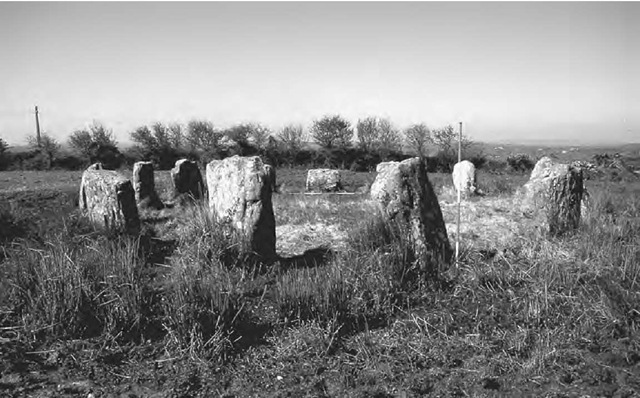Axial stone circles (ASCs), or more correctly axial-stone circles, are a distinctive type of stone circle found only in the southwestern corner of Ireland, in counties Cork and Kerry. Only one other regional group of stone circles bears any resemblance to the axial stone circles: the recumbent stone circles (RSCs) found several hundred kilometers away on the opposite side of the British Isles, in northeastern Scotland. The Irish axial stone circles (ASCs), like their Scottish counterparts, consist of a single stone placed on its side, with all the other stones being set upright. Without exception, this recumbent stone is found in the southwestern or western part of the circle. But unlike the typical Scottish RSC, the recumbent in Irish ASCs is modest in size. The remaining stones in the circle tend to increase (not decrease, as with the RSCs) in height around to the opposite side, where we find a pair of uprights, generally the tallest, known as portals, because it is easy to imagine them forming an entrance into the circle. All of the remaining stones are placed symmetrically in pairs about the axis passing between the portals, across the circle and through the middle of the recumbent stone. This distinctive symmetry means, for one thing, that there is always an odd number of stones in these circles (from five to nineteen). Perhaps more importantly, it also emphasizes the axial orientation. This raises the intriguing question of why it seems to have been so important to orient this axis in a westerly or southwesterly direction (taken from the portals toward the recumbent stone).
The nature of the link between the two groups of monuments is unknown. The Scottish RSCs appear to be older, dating perhaps toward the end of the third millennium b.c.e., while the ASCs appear to extend well into the second millennium. However, secure archaeological dating evidence is still scarce. Postulating a direct link, some authors refer to the axial stone circles as recumbent stone circles; others warn against prejudging the nature of the interrelationship between the two groups and argue in favor of a distinctive term for a distinctive group of monuments.
Despite some systematic differences, the strong resemblance—both in form and orientation—between these two geographically separate groups of stone circles is undeniable. It is perhaps surprising, then, that when we look more closely at the individual orientations of the ASCs we find that—quite unlike the RSCs—they were not guided by particular topographic or astronomical considerations in any consistent way. Unlike their Scottish counterparts, where there is a clear preference for a reasonably distant horizon behind the recumbent, the ASCs are found in a variety of topographic situations, some with high ground rising close behind the recumbent and blocking the distant view completely. And unlike the RSCs, where there is a consistent pattern of orientation in relation to the moon, the Irish sites show no consistent pattern in relation to any astronomical body.
The lesson to be learned here is that a variety of considerations may have influenced the location and orientation of any prehistoric ritual monument, including topographic factors (relationships to prominent natural features such as visible mountains, sacred places, water sources, and so on) as well as the heavenly bodies. In different places and different times, different considerations might have held sway according to the dominant tradition. While some elements of prevailing traditions may be carried forward from place to place and through time, others may be modified or be abandoned. The sky forms only one part of a much bigger picture, even where we do have clear and consistent astronomical alignments. Whatever the links between these two very distinctive stone circle traditions at the opposite sides of Scotland and Ireland, it is clear that the strong astronomical (and specifically, lunar) associations of the Scottish RSCs were not transmitted across to their Irish counterparts.
The axial stone circle at Reenascreena South, Co. Cork, Ireland, viewed along its axis in the direction from the portals towards the recumbent stone.
The lack of consistent astronomy among the axial stone circles does not necessarily mean that one or two individual examples could not have been deliberately astronomically oriented, for reasons specific to a particular place and time. The most quoted examples are Drombeg, near Ros O gCair-bre (Ross Carbery) on the south coast of County Cork, a well-preserved circle whose axis points toward midwinter sunset; and nearby Bohonagh, which faces more or less due west and has been claimed as aligned upon sunset at the equinox. However, the fact that Drombeg is the only one of several dozen large axial stone circles with a clear solstitial alignment must raise the possibility that this could have arisen by chance, and the equinoctial in terpretation of Bohonagh is subject to certain difficulties that pertain to all putative equinoctial alignments.

